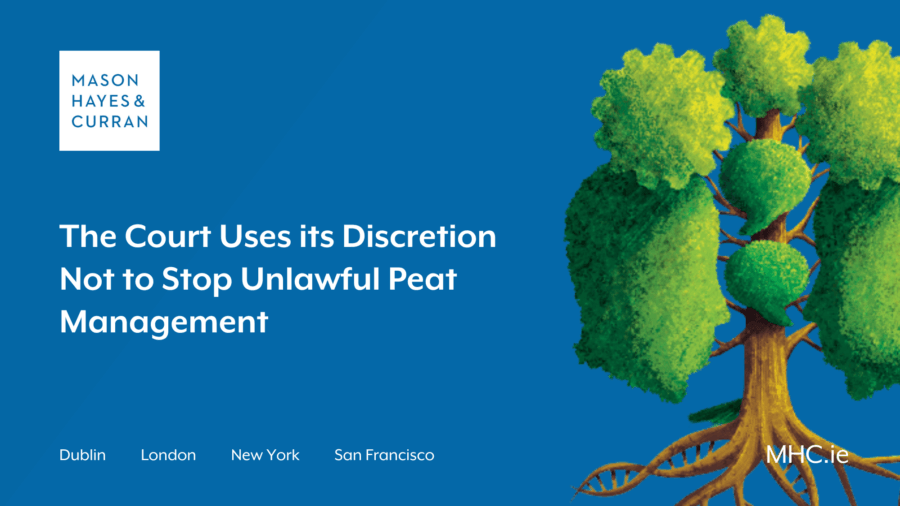
A recent case[1] concerning an application to the High Court for an injunction in accordance with Section 160 of the Planning and Development Act 2000 (PDA 2000) has set an important precedent on what factors will be considered by a court when exercising its discretion on granting planning injunctions.
Background
Clonsura bog is owned by the Cavan Peat Limited (Cavan Peat) and leased by Westland Horticulture Limited (Westland). Westland began industrialised peat milling and harvesting on the bog in 1999. A windfarm developer, Coole Windfarm Limited (CWL), has planning permission to build thirteen wind turbines, four of which are to be located on the bog.
The Section 160 applicants, North Westmeath Turbine Action Group CLG, claimed that:
- Unauthorised peat development works were taking place which had caused environmental damage
- These works were being carried out to facilitate Coole Wind Farm under an “engrafting agreement” between Westland and CWL, that is, a development cannot be “engrafted” onto an unauthorised development, and
- CWL was required to discharge pre-commencement conditions before carrying out site investigation works
Milling activities development and not exempted development
In April 2013, An Bord Pleanála (the Board) issued a Section 5 declaration that the peat milling activities of Westland at Clonsura were development but were not exempted development. Following a legal challenge, this decision was upheld by the High Court. The Government subsequently introduced a form of exempted development that Westland relied on until the corresponding legislation was successfully challenged in July 2019.
Westland said it stopped milling activities at this point. The milling activities were also the subject of a separate Section 160 application by Friends of the Irish Environment CLG where it was agreed that only "winterisation measures", such as the maintenance of drainage infrastructure and outfalls as well as clearing the silt pipes and ponds, could continue pending its application to the Board for substitute consent.
In May 2020, the Board granted Westland leave to apply for substitute consent. The Board also granted an extension of time for making the application due to the existence of court proceedings and Westland has a live application before the Board. The Applicant also challenged the Coole Wind Farm planning permission, which is subject to a stay and a High Court judgment is awaited.
Unauthorised winterisation measures
The Court held that the Applicant had met the burden of proof to demonstrate that Westland have been and continue to be engaged in winterisation measures (designed to ensure silt pipes and ponds are cleaned out so as to avoid environmental damage). Those measures fell under the original Section 5 declaration and are therefore unlawful unless and until the substitute consent is granted. Westland failed to show that the measures come within the exemption at Section 4(1)(h) of the Planning and Development Act. This was, in part, due to a lack of independent expert evidence explaining how those winterisation measures only affect the interior of a structure.
Although unlawful, the Court exercised its discretion not to grant an injunction stopping the winterisation measures. The Court set out a number of factors justifying its decision. Firstly, the works were only minor in scale. The Court also accepted Westland’s evidence, rather than the applicants, that stopping the works would create a risk of environmental damage. In addition, the purpose of the unauthorised development is peatland management and not for the purpose of preserving the bog for the resumption of peat farming.
Engrafting agreement
The Court did not consider that the winterisation works were being carried out to facilitate the wind farm. The applicants failed to establish the presence of an agreement between the wind farm developer, Cavan Peat and Westland requiring the winterisation works to be carried out. Therefore there was no “engrafting” of the wind farm development onto the unauthorised peat development. Cavan Peat and Westland had provided access to the wind farm developer to complete site investigation works, but this access was not unauthorised development.
Site investigation works
The Court accepted the wind farm developer’s evidence that the works did not form part of the planning permission and instead were for the purpose of examining the nature of the subsoil. This was a form of exempted development and therefore the pre-commencement planning conditions did not need to be discharged in advance.
Conclusion
Even though Ms. Justice Bolger considered the winterisation works to be unlawful, the Judge exercised her discretion not to grant injunctive relief restraining the measures. However, the Applicant was given liberty to vary the exercise of this discretion if Westland’s winterisation measures continue for an unacceptable period of time into the future without any progress on the application for substitute consent. This case demonstrates the importance of expert evidence in support of arguments over whether measures are causing harm to the environment.
If developers are seeking to rely on the exemption for the purpose of surveying land or examining the depth and nature of the subsoil, this case demonstrates the importance of providing evidence to demonstrate the works fall within the scope of the exemption and do not form part of a planning permission.
For more information and expert advice, contact a member of our Planning & Environment team.
The content of this article is provided for information purposes only and does not constitute legal or other advice.
[1] North Westmeath Turbine Action Group CLG & Westland Horticulture Limited, Cavan Peat Limited and Cool Windfarms Limited [2023] IEHC 3 [2020/177 MCA]
Share this:






